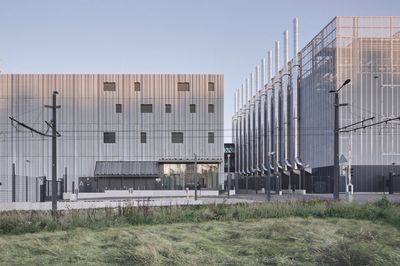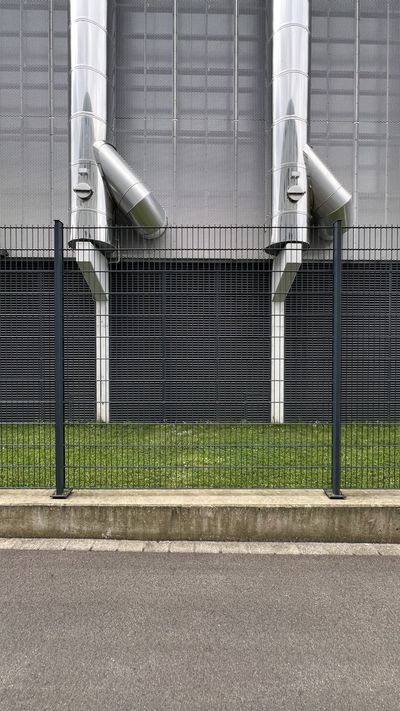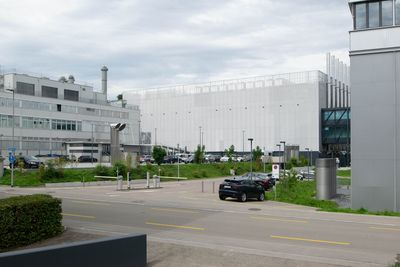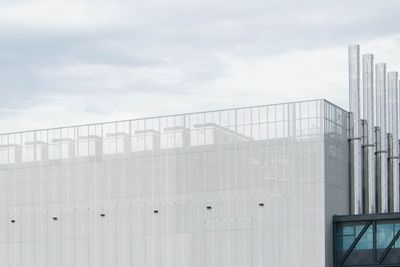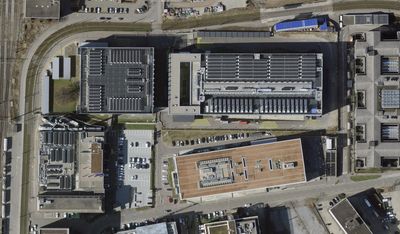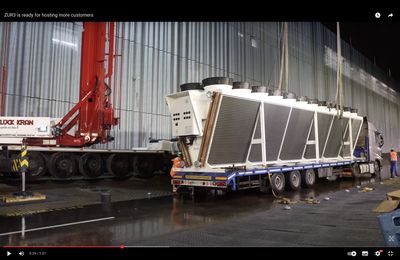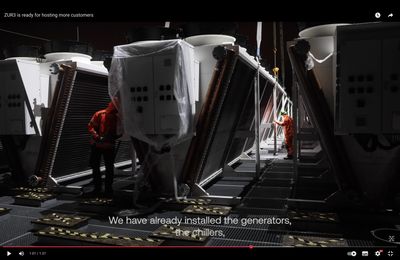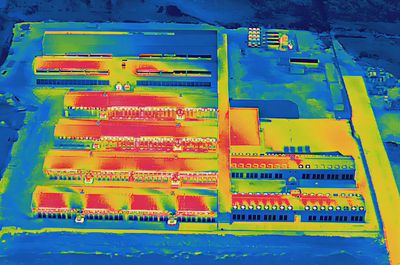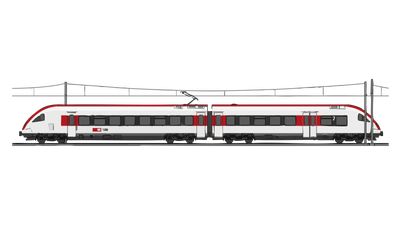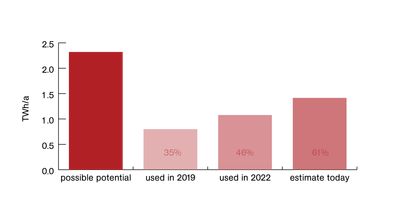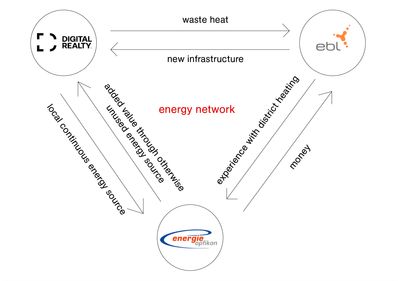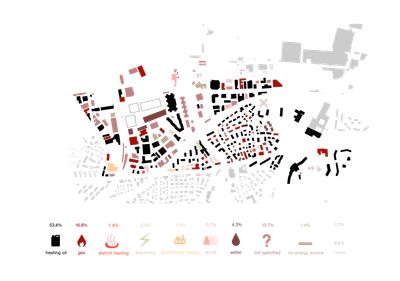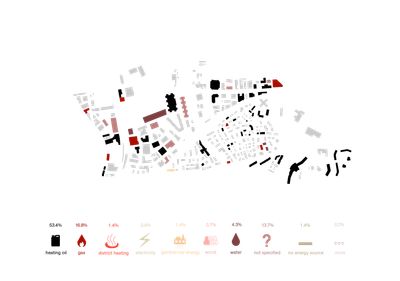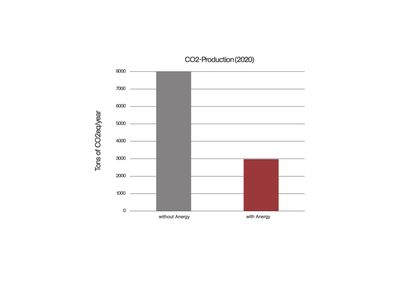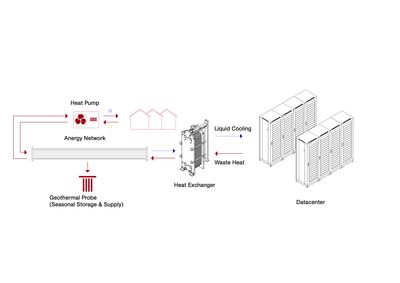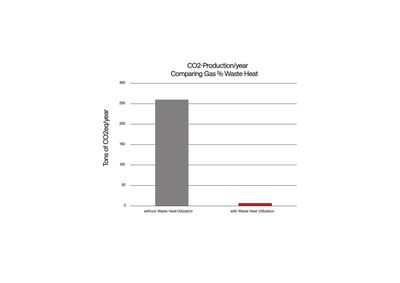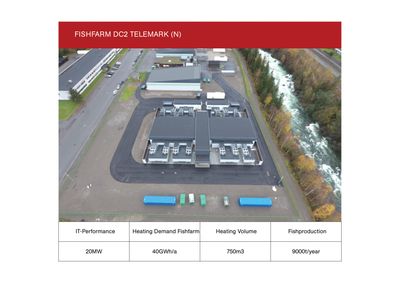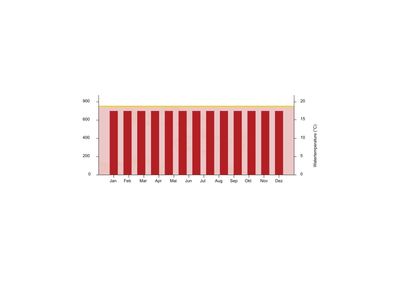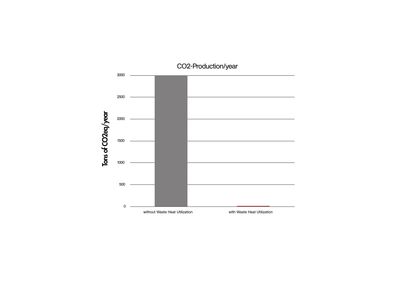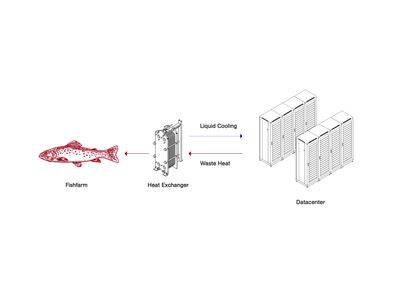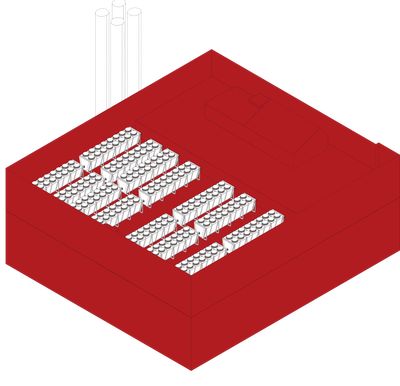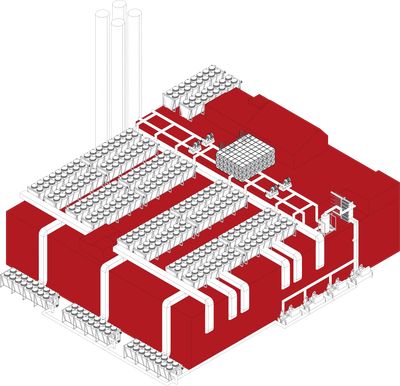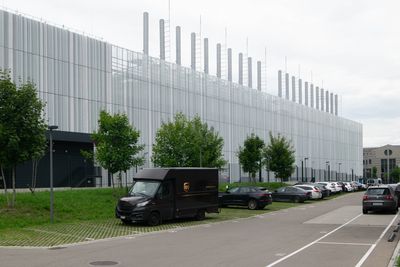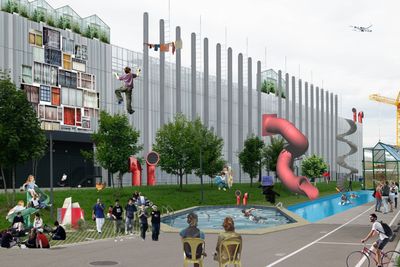AtlasHeating and CoolingSerena Peier, Rebecca Grobotek, Matteo Bianchi, and Linus Ham
Data centres are the invisible pillars of the cloud and are increasingly shaping the physical landscape. They produce enormous amounts of waste heat, the potential of which usually remains untapped. This dual role of places of intensive cooling that are also sources of energy, is examined in this research. Using the example of the data centres in Zurich Glattbrugg, it shows how technical systems, energy flows, and urban networks intertwine.
The work interrogates how data centers can evolve from isolated “fortresses” to open forums, becoming ecologically and socially integrated infrastructures where heat becomes visible and usable as a shared resource.
Hot to Spot a Data Centre
You can (almost) always tell when you’re standing in front of a data centre. No windows, no openness, no trace of life: a box wrapped in perfectly brushed aluminium, gleaming like an oversized USB stick dropped in the middle of nowhere. Walk around it and you’ll begin to notice the signs: fences, cameras, and yellow border lines warning you off. Long silver pipes reach skyward: lifelines powered by diesel, ready to keep servers alive when the grid falters.
Above, the rooftops pulse with an industrial rhythm; coolers, fans, and pipes forming a dense mechanical landscape that the aluminium facade below works so hard to disguise. From the sky, though, the truth becomes visible. Here, the most distinctive feature of a data centre stands out: the coolers.
In Glattbrugg, airplanes flying overhead have a perfect view of these rooftop chillers that mark the buildings unmistakably as data centres. Installing this equipment often happens at night, away from sight. More than 850 tons of machinery lifted under darkness, the work continuing while the city sleeps. At night, lit only by work lamps, the site resembles a tunnel, as if all the infrastructure was underground. Even test runs for the chimneys are done in the dark, when diesel engines exhale their dark smoke, quietly out of view. Seen this way, data centers are not really buildings in the conventional sense, they are infrastructure.
Cooling Infrastructure: Keeping the Cloud Alive
At first glance, the data center Blönduos in Iceland is barely distinguishable from any ordinary industrial facility. Its architectural camouflage is enhanced by a deliberate integration of the cooling infrastructure, which is largely concealed from exterior view. For the casual observer, the absence of visible cooling hardware suggests minimal thermal output.
Yet, when subjected to thermal imaging, the building’s true nature is revealed. Even small data centres, such as this example, emit substantial quantities of waste heat, invisible to the eye but clearly mapped in infrared.
The majority of this excess heat is dissipated through arrays of rooftop chillers: modular units that have become nearly emblematic of contemporary data centre design. Even for data centres of modest size, the arrangement and scale of chillers and piping illustrate the complexity required for reliable thermal regulation. Data centres commonly feature only two main archetypes of server racks, each with its advantages and disadvantages. Despite the apparent simplicity of rack layouts, the spectrum of cooling solutions adopted is extraordinarily varied, often scaling up to monumental proportions.

The choice of cooling system is intrinsically linked to climate. Mapping global climate zones alongside the most prevalent regional cooling methods illustrates a strong correlation between climatic conditions and cooling system selection, especially in Asia and Oceania.
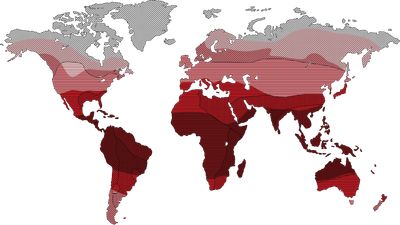
PREDOMINANT COOLING STRATEGY BY REGION
Source: Microsoft, 2023.
 Polar zone
Polar zone Subpolar Zone
Subpolar Zone Temperate Zone
Temperate Zone Subtropical Zone
Subtropical Zone Tropical Zone
Tropical Zone Free Air Cooling
Free Air Cooling Adiabatic Cooling
Adiabatic Cooling Mechanical Cooling
Mechanical Cooling High-efficiency Mechanical Cooling
High-efficiency Mechanical Cooling
In subpolar climates, free air cooling is widely implemented and strongly promoted as highly sustainable, operationally efficient, and effective in reducing both energy and water consumption. The system leverages cold ambient air, particularly during extended seasons of low outdoor temperatures. This technique is frequently blended with adiabatic cooling in temperate regions to optimise efficiency during periods of fluctuating environmental conditions. Also the DigitalRealty data center in Glattbrugg, Switzerland, uses for much of the year free air cooling suffices, with ambient air itself serving as the primary medium for heat exchange. The inner cooling circuit and outer circuits remain isolated, preserving efficiency and operational safety.
In almost all setups, plate heat exchangers act as mediators between circuits, enabling heat transfer without direct mixing of fluids. Their repeated appearance in schematics and technical photographs is a testament to their ubiquity within advanced data centre engineering. The potential for sustainable energy redistribution is exemplified by the role of plate heat exchangers in waste heat recovery. These devices facilitate the transfer of thermal energy from data centre cooling loops to external consumers such as local housing cooperatives or district heating networks. Such repurposing of byproduct heat represents a promising avenue for urban energy synergies and reduced overall carbon footprint.
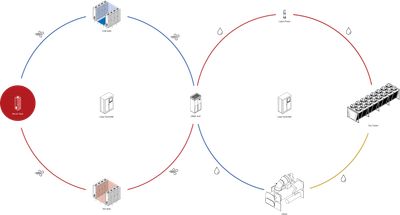
FREE AIR COOLING SYSTEM
Hot server air is cooled in CRAC units and recirculated to the servers. The Warm coolant is sent to dry coolers for outside air cooling; if external temperatures are high, it is additionally cooled by a chiller before returning to the CRAC.
 hot
hot warm
warm cold
cold liquid
liquid air
air
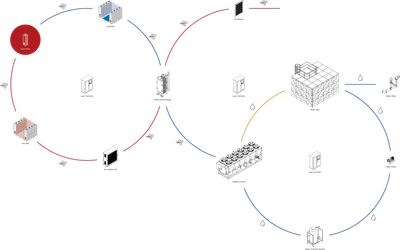
ADIABATIC COOLING SYSTEM
Hot server air is extracted by air handling units and passed through a plate heat exchanger, where it is cooled by outside air. The cooled air returns to the servers. The cold air in the heat exchanger is supplied by an adiabatic cooler, which cools outside air via water evaporation. Exhaust air from the heat exchanger is released outside.
 hot
hot warm
warm cold
cold liquid
liquid air
air

RIVER-/LAKEWATER COOLING SYSTEM
Hot server air is cooled by CRAC units. The CRAC coolant is chilled using liquid-to-liquid plate heat exchangers. The cool water for these exchangers comes directly from a lake or river and is cleaned by filtration and sediment processes. Warm water exiting the heat exchangers is returned to the lake.
 hot
hot cold
cold liquid
liquid air
air

LIQUID COOLING SYSTEM
Servers are cooled directly by liquid. Hot liquid from the servers flows into a liquid-to-liquid plate heat exchanger, where it is cooled and then recirculated back to the servers. The cold liquid for the plate heat exchanger is chilled by circulating through cooling towers and chillers.
 hot
hot warm
warm cold
cold liquid
liquid
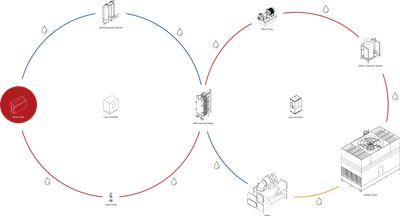
IMMERSION COOLING SYSTEM
Servers are submerged in a coolant bath. The liquid is often cleaned and demineralised. Hot coolant is cooled in a plate heat exchanger and then circulated back to the cooling tank. The cold liquid for the plate heat exchanger is chilled by circulating through cooling towers and chillers.
 hot
hot warm
warm cold
cold liquid
liquid
Heat as a Resource

A 45 MW DATACENTER HAS A HEAT OUTPUT OF 51’694'500 WATT
 0.01% people
0.01% people 1% lighting
1% lighting 2.9% power distribution
2.9% power distribution 9% UPS with battery
9% UPS with battery 87% IT-equipment
87% IT-equipment
The magnitude of waste heat produced by a typical data centre is often underestimated. Consider a facility with a computational capacity of 45 megawatt (MW): the combined power of the three data centres of Digital Realty in Glattbrugg. Such a center generates approximately 51.5 MW of thermal energy as waste heat. If recovered with perfect efficiency, this output could supply the entire thermal energy demand (for residential and non-residential uses) in Zürich’s Altstetten district. Alternatively, the same quantity of heat could operate 70 public swimming pools. Or if converted entirely to electrical energy, enable 18.8 InterCity train journeys from Zurich to Bern every hour. These comparisons illustrate not only the extraordinary energy density inherent in data centre operations, but also their potential for contributing positively to broader urban infrastructure.
Waste Heat Potential
The realistic waste heat potential from data centers in Switzerland is between 2.02 and 2.62 terawatt hour per year (TWh/a) (median 2.32 TWh). In 2019, 35 % of data centres utilised this waste heat. By 2022, 46 % did, with another 15 % planning to do so. This gives a mid-term usage potential of 46–61 %. This waste heat could provide heating and hot water to 140,000–185,000 households (3.7–4.7 % of all Swiss homes), saving 420,000–555,000 tonnes of CO₂ per year by replacing fossil heating. Unlike other industries, data centres produce waste heat at a constant, reliable rate, year-round, 8,760 hours per year, making them secure sources for heating networks.
Energy Network Airport City
In projects like the Airport City Energy Network near Zurich Airport, operators aim to recycle the warmth produced by Digital Realty’s facilities. Doing so could save 15,000 tons of CO₂ annually, the equivalent of 5.6 million liters of heating oil.
In a high-temperature waste heat network, the waste heat is usually extracted at a temperature level between 20°C and 30°C and then raised to the required level of 65°C–80°C using a heat pump. This allows even low-temperature waste heat from data centres to be used while still supplying areas that require higher temperatures (e.g., older buildings). The downside is higher investment costs and reduced energy efficiency due to the heat pump. After, it is distributed to customers through a network of pipes for heating, hot water production, or cooling. The goal is to use local energy more sustainably and reduce CO₂ emissions.
The three main players are DigitalRealty, which would supply the waste heat; EBL, which brings experience with district heating networks; and Energie Opfikon AG, responsible for providing the city with water and electricity.
Compared to the current energy sources within the energy network, about 70 % comes from heating with oil and gas, which are fossil fuels that should be avoided whenever possible.
Looking at the map of potential waste heat recipients, it quickly becomes apparent that only a small number of buildings are affected; about one-third of the possible consumers within the energy network. This is even more surprising given that the potential waste heat from the data centres is actually much greater than the total heat demand of the entire network. Comparing these two maps, it becomes clear that primarily oil-fired boilers would be replaced, which would be a step toward renewable energy. However, looking at the grey areas, which show buildings not interested in connecting to the district heating network, there is a large amount of untapped potential. But why is this the case? Are there alternative energy sources that are more attractive? Or are the costs and associated risks too high?
The idea of an energy network has currently been put on hold because the city and project partners could not agree on the terms. This creates even more uncertainty for potential future waste heat customers. They would be committing to a long-term contract without being able to predict how the network will develop. On the other hand, these customers are exactly what the network needs, an energy network is only viable if there is sufficient demand for it to pay off someday. But just the thought that the waste heat is being emitted and lost right next door every day is insane. Wondering: isn’t it possible to find a compromise among all the stakeholders to take a step toward climate goals?
Waste Heat Usage
Waste heat represents a largely underutilised resource. In Switzerland, 35 % of available waste heat was recovered in 2019, leaving 65 % unused. Globally, the situation is more striking with only 3 % currently recovered, while 97 % going to waste.
Industrial processes and data centres generate considerable thermal energy that could be captured and reintegrated into heating systems. Waste heat recovery offers a practical approach to reducing primary energy demand and CO₂ emissions.

Waste Heat Utilisation in Switzerland in 2019.
- 35% used
- 65% unused

Waste Heat Utilisation globally in 2024.
- 3% used
- 97% unused
Waste Heat Utilisation: Three Case Studies
Waste heat from data centres can be utilised in diverse ways. The Swisscom facility in Zurich supplies over 2300 homes through an anergy network, saving more than 3000 tons of CO₂ annually. In the Netherlands, a data centre heats commercial greenhouses, while a Norwegian facility maintains optimal temperatures for large-scale farming.
These examples demonstrate the versatility of waste heat recovery. From residential heating to agricultural and aquaculture applications. Each project significantly reduces CO₂ emissions while turning previously wasted energy into a valuable resource.
From Fortress to Forum: Data Centres as Civic Infrastructure
Waste heat could become part of the urban metabolism, tying digital infrastructure into physical cities. Can data centres evolve into living, adaptive, or hybrid ecological systems? If computation was a public good, what would its architecture look like? Can visibility and design reclaim these buildings from anonymity and make the cloud a civic utility, not just a corporate fortress?
